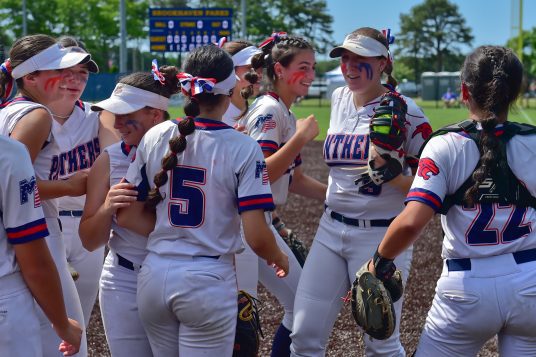By Samantha Rutt
At the Monday, June 10, Port Jefferson Civic Association meeting, new officers were sworn in, an update on the looming Staller development in Port Jefferson Station was given, and civic members took part in brainstorming ideas and solutions for the village’s most pressing issues.
The new leadership team, with terms expiring in 2026, were officially sworn in by neighboring civic president Ira Costell. The officers sworn in were Ana Hozyainova as civic president, Holly Fils-Aimé as vice president, Marilyn Damaskos as treasurer, Janice Fleischman-Eaton as recording secretary and Kathleen Mc Lane as corresponding and outreach secretary.
Jefferson Plaza development proposal updates
Following the official business, Costell, president of the Port Jefferson Station/Terryville Civic Association shared some updates pertaining to the proposed Staller redevelopment of Jefferson Plaza, a development he feels will have a big impact on nearby communities.
“This significant development will, for better or worse, change the face and future of our community, as well as impacting Lower Port,” Costell shared. Back in March, Costell, on behalf of the PJSTCA, wrote a letter to Town of Brookhaven board and the town’s Highway Department [see “Port Jefferson Station/Terryville civic requests traffic study,” from May 3] asking for a comprehensive study to assess the influx of traffic from this proposal.
Since then, the PJSTCA has heard back from Town of Brookhaven councilmember, Jonathan Kornreich (D-Stony Brook), who agreed with the sentiments expressed in the letter and assured that the town “shares the concern about the cumulative impact these developments may have on traffic” and “would like to stay ahead of it.”
Others chimed into Costell’s speech and shared concerns about the potential impact on traffic, as well as quality of life and affordability, while others emphasized the need for comprehensive planning and coordination — something Costell has advocated for since the developer’s initial proposal.
“Our community has chosen to not throw up a blockade and say no more, not in our backyard,” Costell said. “We embrace and want to engage with a future that makes sense for our community, that we can digest properly. Without comprehensive planning and coordination, it could be a nightmare that’s going to impact our communities negatively.”
In recent years, the village has seen substantial development and its impacts on the community. Both, the Overbay and The Shipyard complexes have left an impact on the community as residents feel the respective developers were not overtly transparent in their building plans.
Local architect, Heather Brin, echoed these sentiments sharing notes from her expertise, “The Shipyard, downtown, is illegal in terms of the height,” Brin alleged. “The developers raised the level of the berm that the property sits on so they could build as high as they did.”
Civic members have since questioned the Staller project’s viability, safety concerns and the importance of finding a balance between developer and community needs. The PJSTCA will host Staller Associates on June 20 at 7 p.m. at the Comsewogue Public Library, 170 Terryville Road, Port Jefferson Station, to continue the community conversation.
Village issues going forward
Shifting gears, Hozyainova asked civic members to bring issues, concerns and wishes for the village to the forefront of the conversation. From this, several pressing issues resurfaced and some new ones emerged.
Residents campaigned for increased walkability of the village, sharing notes of overgrown vegetation limiting sidewalk access. To this, Fils-Aimé asked for increased volunteerism and formation of committees dedicated to their respective concerns.
“Bring a proposal forward, somebody has to lead the charge,” she said. “We can have multiple committees, maybe a couple people are interested in that [issue] or maybe you want to bring them here and have them join the civic association.”
Others shared their respective concerns over the Port Jefferson power plant and its future, capital projects in the village and in the school district, village constable’s office hours, the future of the country club and the East Beach bluff, keeping and restoring trees and other natural vegetation, were among some of the many issues brought to the metaphorical table.
LIRR electrification
Adding to the growing list of village concerns, Port Jefferson resident Bruce Miller brought a motion before the civic requesting that Gov. Kathy Hochul (D) makes enforcement of the state’s Climate Leadership and Community Protection Act a priority of the Metropolitan Transportation Authority and the Long Island Rail Road in their new 20-year plan.
Miller explained in his motion that diesel locomotion is no longer acceptable transportation under this act and that riders along the Port Jefferson Branch are “forced to use their internal combustion vehicles to drive to Ronkonkoma for a decent ride,”
In addition to concerns with ridership and the environment, Miller also detailed that the utilization of hydrogen rail or separate-car battery transportation could allow for a large industry based in New York state — to the benefit of many.
The motion to approve Miller’s proposal asking Hochul and LIRR President Robert Free to meet with the civic association and Suffolk County’s elected representatives was approved and will be subsequently shared with all necessary parties.
The next Port Jefferson Civic Association meeting will be held on Aug. 12 at the Port Jefferson Free Library, 100 Thompson St., at 6:30 p.m.














































































